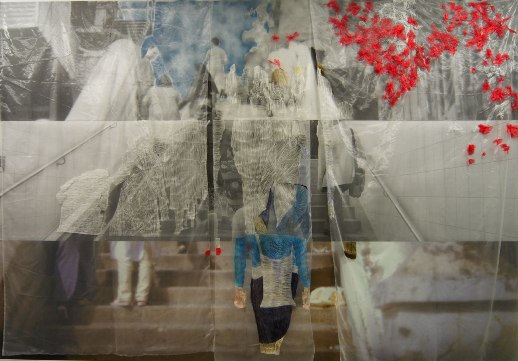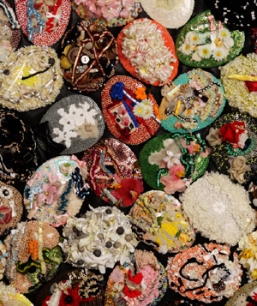Neglected Craft
Setting out to write about “Stitch by Stitch: Traces I Made with Needle and Thread” I warn myself to beware of succumbing to wordplay. Just a cursory review of potential pitfalls pulls up “weave a story,” “string together words,” “tie-up loose ends,” and “the threads that bind us.” Preferring to err on the side of caution, I should probably avoid metaphors involving “fabric” (as a description of memory or life) and the word “stitch” entirely, though it is a useful verb for depicting the act of connecting thoughts and ideas. I value contemporary art, in part, for its ability to offer new readings and create fresh vocabulary. It is with this, er, frame of mind that I will attempt to distill my thoughts on the current exhibition at the Teien Art Museum.
“Stitch by Stitch” is a group show featuring seven artists and one collective, all of them contemporary, who work in needle and thread. As curator Kasumi Yamaki notes in her essay in the exhibition catalog ‘Assemblage of Decisions and Deft Resolutions,’ it is a concept that elicits confusion (embroidery, contemporary?) at best and, at worst, condescension. Given that the language we use to describe narrative-making and inter-personal relationships (at least in English) is so indebted to the craft, why do we not grant needlework greater importance? Is it because, having worked itself into our very speech, it has become something of the mundane? Or is it because, having won over so few contemporary artists, it seems somehow irrelevant?

The works currently on display at the Teien Art Museum are, for the most part, happily relevant. For some artists, embroidering is a self-conscious act, the nature of which is addressed in the work itself; for others, putting together needle and thread is simply a means (and a process) to an end. Aiko Tezuka shows that while embroidery can mimic the picture-making ability of traditional mediums like paint, the tangibility of thread contains a sculptural potential as well. Zon Ito, who creates abstract, minimalist tapestries out of dream-inspired sketches, muses on the tedious, yet contemplative, act of stitching versus the immediacy of putting pencil to paper. Meanwhile, the very presumption of thread on cloth is questioned by Sayaka Akiyama, who employs such diverse materials as plastic bottle labels, discarded coupons, and an eyeglass strap to mark her personal trajectory on screened images of maps.
 With applications in both art and fashion, embroidery is also uniquely primed to explore the human desire for adornment. This aspiration, at once beautifying and cancerous, is explored by both Ruriko Murayama and Asami Kiyokawa. By way of contrast, Kei Takemura’s floss-like white threads of Japanese silk on semi-sheer fabric, which hang over larger than life photographic portraits, give her subjects an ethereal, divine quality. Beyond subject, space, and form, the simple act of stitching can be a Penelopean endeavor marking the passage of time, as Tsunao Okumura’s ‘The Night Watch Embroidering’ shows. It can also be therapeutic, as demonstrated by the Nui Project, an embroidery workshop at the Shobu Gakuen rehabilitation center in Kagoshima.
With applications in both art and fashion, embroidery is also uniquely primed to explore the human desire for adornment. This aspiration, at once beautifying and cancerous, is explored by both Ruriko Murayama and Asami Kiyokawa. By way of contrast, Kei Takemura’s floss-like white threads of Japanese silk on semi-sheer fabric, which hang over larger than life photographic portraits, give her subjects an ethereal, divine quality. Beyond subject, space, and form, the simple act of stitching can be a Penelopean endeavor marking the passage of time, as Tsunao Okumura’s ‘The Night Watch Embroidering’ shows. It can also be therapeutic, as demonstrated by the Nui Project, an embroidery workshop at the Shobu Gakuen rehabilitation center in Kagoshima.
That last paragraph, I admit, relies a little too much on convenient symbolism. Suffice to say I was more charmed with some works than others; yet taken as a whole “Stitch by Stitch” portrays enough diverse movements in embroidery to make a compelling argument for the artistic legitimacy of the craft. There is also the additional experience of seeing these works against the backdrop of the Teien Art Museum’s own unique textures and decorative elements. Each artist is afforded his or her own room (or rooms) and the feeling of intimacy that this allows reflects upon the traditionally domestic and ultimately hands-on act of stitching.
You can also read an interview with Sayaka Akiyama published on TABlog recently.
Rebecca Milner
Rebecca Milner



